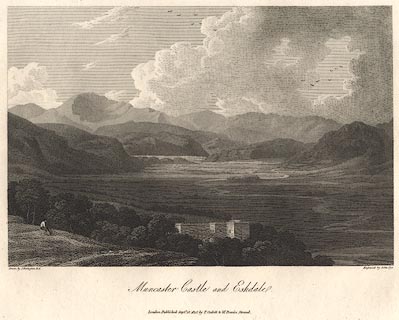

private collection (75)
image:-
© see bottom of page

click to enlarge
Plate 26 in The Lakes of Lancashire, Westmorland and Cumberland ... with text by Thomas Hartwell Horne:-
VIEW OF MUNCASTER CASTLE. / THE Manor of Muncaster is known to have belonged to the Pennington family as early as the reign of Henry II. Sir John Pennington, who lived in the reign of Henry VI., is said to have secreted that unhappy monarch in his flight from his enemies; and the tradition of the family is, that on quitting Muncaster he presented his host with a small glass vessel, still preserved in the family, and called the Luck of Muncaster, to the preservation of which a considerable degree of superstition is attached. This Sir John Pennington is said to have been a distinguished military character, and to have commanded the left wing of the English army in an expedition against Scotland. His grandson, of the same name, was in the battle of Flodden Field. Another descendant, of the same name, was Admiral to King Charles I. and much trusted by that monarch in naval affairs. Sir William Pennington, grandson of the last-mentioned Sir John, was created a Baronet in 1676. Sir John Pennington, the fifth Baronet, was, in 1783, created Lord Muncaster, of the Kingdom of Ireland; he died in 1813, leaving only one surviving daughter, married to Lord Lindsay, son of the Earl of Balcarras, when the title of Muncaster and the Muncaster estates, being settled on male heirs, devolved to his brother, General Lowther Pennington, now Lord Muncaster. / Muncaster cstle, which retains the principal tower of the ancient fortifiied mansion, though it has lost its original form, was nearly rebuilt by the late Lord Muncaster. It stands on an eminence, nearly surrounded by beautiful plantations, and commanding in front a fine view of the Vale of Esk, flanked on each side, and terminated in front, by the wildest mountain scenery. In the house are several family pictures, and a curious portrait of Thomas Skelton, the fool of Muncaster, who is said to have lived in the family at the time of the civil wars, and of whose sayings there are many traditional stories. / The River Esk, which gives its name to Eskdale, is formed by some small streams which rise near Bow-fell; it falls into the sea at Ravenglass, after a course of about thriteen miles.
Drawn by J. Farington R.A. / Engraved by John Pye. / Muncaster Castle and Eskdale. / London Published Septr. 15, 1815, by T. Cadell & W. Davies, Strand.
 Muncaster Castle and Eskdale
Muncaster Castle and Eskdale